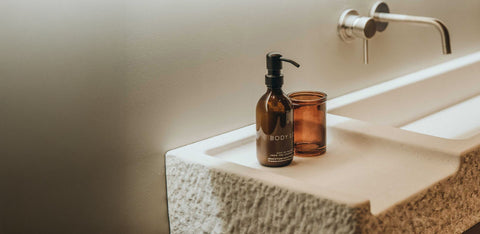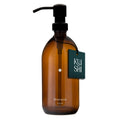Every morning, as you reach for soap to begin your day, there's an opportunity—small, perhaps overlooked, yet meaningful.
Your soap dispenser has the potential to support conscious living. It's a quiet declaration of values that speaks to how you move through the world and the ethical choices you make for your home.
In the United Kingdom alone, 35.8 million plastic bottles are used each day, yet only 55% of them reach recycling facilities. But you don't need to be part of this statistic. There's another path—one where beauty, functionality, and environmental responsibility coexist.
This guide invites you to explore soap dispensers not as afterthoughts, but as considered design choices that honour both your space and our shared planet.
Inside this Article:
- What are the Different Types of Soap Dispensers?
- How Soap Pumps Actually Work (And Why It Matters for Your Home)
- What Should Your Soap Dispenser Be Made From?
- What is the Actual Environmental Impact of Your Soap Dispenser Choice?
- How to Select Your Perfect Dispenser
- How to Care For and Maintain Your Soap Dispenser
- Troubleshooting Common Issues With Soap Dispensers
- Why Kuishi Dispensers Represent a Considered Choice for Your Home
- An Invitation to Mindful Living
What are the Different Types of Soap Dispensers?

To make truly sustainable choices, you need to know what your options are. Let's break them down:
Manual Hand Pump Dispensers
These represent the most reliable and timeless option. Their straightforward design means fewer points of failure and a longer lifespan—qualities that align perfectly with sustainable living principles.
When you choose a manual pump, you're choosing simplicity and longevity.
Automatic Soap Dispensers
These utilise motion sensors for touchless operation. While they're marketed for their hygiene benefits, they present some limitations you should consider: clinical aesthetics that can feel cold in a home environment, restricted soap choices, and electronic components that introduce maintenance considerations and eventual battery waste.
Wall-Mounted vs. Countertop
Wall-mounted dispensers offer space-conscious solutions, creating clean visual lines that work beautifully in minimalist bathrooms. Countertop dispensers provide portable flexibility, allowing you to position soap precisely where you need it.
Foam versus Liquid
Foam dispensers create an aerated lather whilst using less product per pump—a genuine money-saver. Liquid dispensers accommodate a broader range of natural formulations, giving you more freedom in choosing your preferred soap.
How Soap Pumps Actually Work (And Why It Matters for Your Home)

The hotel industry generates over 440 billion units of solid waste annually, much of which is soap and bottled amenities. It's a surprising statistic, and one that makes you think about how much similar products you're wasting in your own home.
Consider this across your household.
You could be using a typical dispenser where several squirts fall into the sink and down the drain before you even start washing. Now multiply that by every member of your household. It's not just waste—it's money literally going down the drain, which adds up considerably if you opt for premium soap brands.
So, how do you fix this? You start with a quality pump mechanism.
The system comprises the actuator (pump head), housing, dip tube, and interior elements, including a piston, spring, and valve. When you press the actuator, the piston creates pressure while generating a vacuum within the chamber.
This vacuum draws soap upward through the dip tube, defying gravity through air suction.
Here's why quality matters: a well-built dispenser delivers accurate usage measurements with every pump. It's built more professionally, meaning it'll last significantly longer and you won't need to replace it so often, cutting down on your general waste whilst saving money.
What Should Your Soap Dispenser Be Made From?
 The materials you select for your daily objects speak volumes about your priorities as a homeowner. Here's what's on offer:
The materials you select for your daily objects speak volumes about your priorities as a homeowner. Here's what's on offer:
Glass Dispensers
Glass represents perhaps the most considered choice for your home.
Its transparency lets you see exactly when refilling is necessary, encouraging mindful consumption. The material itself is endlessly recyclable without degradation of quality—unlike plastic, which loses integrity with each recycling cycle.
Weight provides remarkable stability. A quality glass dispenser remains steadfast on your surfaces, its heft speaking to substance and permanence. This is not an object designed for obsolescence, but one intended to serve you faithfully for years.
Kuishi has worked with glass dispensers for over eight years, installing them in environments from boutique hotels to corporate offices worldwide. The concern about breakage proves largely unfounded when quality mounting systems or stable bases are employed.
Sustainable Plastic
There are circumstances where plastic dispensers serve legitimate purposes in your home, particularly in households with young children. However, food-safe plastics are essential. Lesser quality plastics may leach microplastics into your soap or release unwanted chemicals.
The truth about plastic dispensers is that they possess a shorter lifespan than their glass counterparts. Over time, repeated squeezing can distort the container, creating an untidy appearance.
They represent a practical choice when your safety concerns outweigh longevity considerations.
Stainless Steel: The Premium Touch
For pump mechanisms, stainless steel offers you superior performance. Its resistance to corrosion makes it ideal for humid bathroom environments, and a quality stainless steel pump will outlast plastic alternatives many times over.
This considered choice aligns function with beauty in your home.
What is the Actual Environmental Impact of Your Soap Dispenser Choice?
 A single plastic bottle requires approximately 450-1,000 years to decompose.
A single plastic bottle requires approximately 450-1,000 years to decompose.
Each disposable soap bottle you purchase represents a choice to contribute to this enduring waste stream, or an opportunity to step away from it entirely.
Refillable dispensers fundamentally alter this equation. Life cycle analysis reveals that reusable containers achieve environmental "break-even" after merely 10 to 20 uses. Beyond this threshold, each refill you make represents a clear ecological benefit.
When you choose to refill rather than replace, you eliminate the environmental burden of manufacturing a new bottle: petroleum extraction, energy-intensive production, transportation emissions, and packaging waste. You step out of a linear system and enter a regenerative cycle.
At Kuishi, this philosophy extends throughout our entire operation.
We've implemented carbon offset programmes and continuously refine our processes to minimise environmental impact. We design products with repairability in mind—a radical concept in an era of planned obsolescence.
Approximately 8 million tonnes of plastic enter our oceans annually. Your individual choice may seem small against such staggering numbers. Yet when multiplied across households and businesses, these decisions accumulate into meaningful change.
How to Select Your Perfect Dispenser
Capacity
Here at Kuishi, we recommend a 500ml or 18oz capacity as an ideal balance for your home—substantial enough to reduce refilling frequency, yet elegant enough to avoid overwhelming your space.
Soap Compatibility
Manual dispensers accommodate most liquid soaps, giving you maximum flexibility. Foam dispensers require either specifically formulated foam soap or a carefully mixed solution—typically 1 part soap to 3 parts water.
Design Harmony
Consider the character of your space. Your dispenser should feel like a natural extension of your bathroom environment rather than an intrusive element.
Pump Quality
A smooth, reliable pump mechanism transforms handwashing from a potential source of frustration into effortless grace. Kuishi offers a 12-month warranty on all dispenser pumps, giving you peace of mind.
Installation Method
Wall mounting creates clean surfaces and works beautifully in minimalist environments. Countertop placement offers you flexibility to move things around as your needs change.
Above all, choose longevity over fleeting trends. A well-made dispenser will serve you faithfully for years to come.
How to Care For and Maintain Your Soap Dispenser
Well-cared-for objects return the favour with years of reliable service in your home.
-
Regular cleaning: Weekly, wipe the exterior with a soft, damp cloth and mild natural detergent. Avoid harsh chemicals or abrasive pads that could damage the finish.
-
Addressing clogs: If your nozzle becomes blocked, disassemble the pump and soak components in warm water for several hours. A soft toothbrush can dislodge stubborn build-up without causing damage.
-
Proper refilling: Avoid overfilling, which can lead to leaking. Leave approximately one centimetre of space at the top. When first filling, pump several times to prime the mechanism correctly.
Troubleshooting Common Issues With Soap Dispensers
-
Weak dispensing: Check your soap viscosity—if it's too thick, dilution with warm water often resolves the problem. Examine whether the dip tube has become dislodged from the pump mechanism.
-
Leaking: Most commonly results from overfilling or improper pump assembly. Empty some soap to create adequate headspace and ensure the pump sits flush against the bottle opening.
-
Clogged nozzles: Remove the pump, run warm water through the nozzle, and use a soft brush to clear the opening. Regular use prevents soap from settling and hardening.
-
Foaming dispenser challenges: Often relate to incorrect soap-to-water ratios. The ideal ratio typically falls around one part soap to three or four parts water.
At Kuishi, we stand behind our products with a comprehensive 12-month warranty on all dispenser pumps. Should you require a replacement pump, these components are readily available directly through the Kuishi website. This approach to repairability represents our conscious rejection of disposable culture.
Why Kuishi Dispensers Represent a Considered Choice for Your Home

Quality manifests in details that reveal themselves through years of daily use in your home.
Kuishi dispensers are crafted with meticulous attention because we understand that sustainability and excellence are inseparable. We source materials with care—glass that meets exacting standards, stainless steel that resists corrosion, and when plastic is necessary, only food-safe grades.
Our relationships with businesses worldwide inform our design process. We learn what works through real-world application in demanding environments, then bring those insights to products for your home.
Perhaps most significantly, Kuishi represents a commitment to sustainability that extends beyond marketing language. We measure our carbon output and implement concrete strategies to offset it.
Our manufacturing processes continually evolve to reduce waste and energy consumption.
An Invitation to Mindful Living
The soap dispenser on your countertop is more than just a functional object—it's a daily reminder that small choices, repeated consistently, create meaningful change.
At Kuishi, we believe that conscious living shouldn't sacrifice beauty or convenience. That's why every dispenser in our collection is designed to serve you faithfully for years, crafted from materials chosen for both their aesthetic appeal and environmental integrity.
Ready to make the switch?
Explore our collection of sustainable soap dispensers at kuishi.com and discover how refillable design honours both your space and our shared planet.
A Gift for Our Community
As our thanks for engaging with this guide, enjoy 15% off any dispenser bottle in our collection. Use code BOTTLEGUIDE at checkout.




